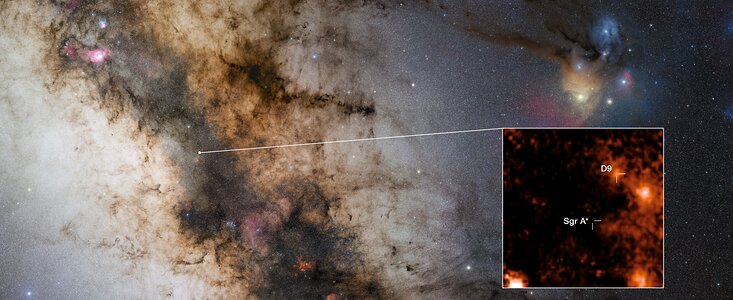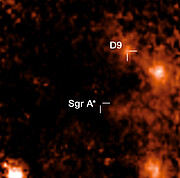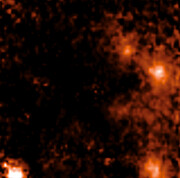Tisková zpráva
První dvojhvězda nalezená v blízkosti supermasivní černé díry naší Galaxie
17. prosince 2024
Mezinárodní skupina vědců objevila dvojhvězdu obíhající v blízkosti Sagittarius A*, supermasivní černé díry v centru naší Galaxie. Je to vůbec poprvé, co byl v blízkosti supermasivní černé díry nalezen hvězdný pár. Objev založený na datech získaných pomocí dalekohledu VLT (Very Large Telescope) na Evropské jižní observatoři (ESO) nám pomáhá pochopit, jak hvězdy přežívají v prostředí s extrémní gravitací. A co víc, mohl by otevřít cestu k detekci planet v blízkosti Sagittarius A*.
"Černé díry nejsou tak destruktivní, jak jsme si mysleli," říká Florian Peißker, vědecký pracovník z univerzity v německém Kolíně nad Rýnem a hlavní autor studie, která byla právě zveřejněna v časopise Nature Communications. Dvojhvězdy, tedy dvojice hvězd obíhajících kolem sebe, jsou ve vesmíru velmi časté, ale nikdy předtím nebyly nalezeny v blízkosti supermasivní černé díry, kde může intenzivní gravitace způsobit nestabilitu hvězdných systémů.
Tento nový objev dokládá, že některé dvojhvězdy mohou krátce prosperovat i za destruktivních podmínek. D9, jak se nově objevená dvojhvězda jmenuje, byla objevena právě včas: její stáří se odhaduje na pouhých 2,7 milionu let. A silné gravitační působení blízké černé díry pravděpodobně způsobí její splynutí v jedinou hvězdu během pouhého milionu let, což je pro tak mladý systém velmi krátká doba.
"V kosmickém časovém měřítku jde o opravdu krátké okno pro pozorování takového binárního systému - a nám se to podařilo!" vysvětluje spoluautorka Emma Bordier, vědecká pracovnice rovněž z Kolínské univerzity a bývalá studentka ESO.
Po mnoho let se vědci také domnívali, že extrémní prostředí v blízkosti supermasivní černé díry brání vzniku nových hvězd. Několik mladých hvězd nalezených v těsné blízkosti Sagittarius A* tento předpoklad vyvrátilo. Objev mladé dvojhvězdy nyní ukazuje, že i hvězdné páry mají potenciál vznikat v těchto drsných podmínkách. "Systém D9 vykazuje jasné známky přítomnosti plynu a prachu v okolí hvězd, což naznačuje, že by se mohlo jednat o velmi mladý hvězdný systém, který musel vzniknout v blízkosti supermasivní černé díry," vysvětluje spoluautor Michal Zajaček, vědecký pracovník Masarykovy univerzity v Brně a Univerzity v Kolíně nad Rýnem.
Nově objevená dvojhvězda byla nalezena v husté hvězdokupě hvězd a dalších objektů obíhajících kolem Sagittarius A*, nazývané hvězdokupa S (S cluster). Nejzáhadnější objekty v této hvězdokupě jsou tzv. objekty typu G, které se chovají jako hvězdy, ale vypadají jako oblaka plynu a prachu.
Právě při pozorování těchto záhadných objektů objevila skupina překvapivý vzorec u objektu D9. Data získaná pomocí přístroje ERIS na VLT v kombinaci s archivními daty z přístroje SINFONI odhalila opakující se změny rychlosti hvězdy, což naznačuje, že D9 jsou ve skutečnosti dvě hvězdy, které obíhají kolem sebe. "Myslel jsem si, že moje analýza je chybná," říká Peißker, "ale spektroskopický vzorec pokrýval asi 15 let a bylo jasné, že tento objev je skutečně první dvojhvězdou pozorovanou v hvězdokupě S."
Výsledky vrhají nové světlo na to, co by mohly být ony záhadné objekty G. Tým předpokládá, že by se ve skutečnosti mohlo jednat o kombinaci dvojhvězd, které se ještě nesloučily, a zbytků materiálu z již sloučených hvězd.
Přesná povaha mnoha objektů obíhajících kolem Sagittarius A*, stejně jako to, jak mohly vzniknout tak blízko supermasivní černé díry, zůstává záhadou. Brzy by to však mohla změnit modernizace GRAVITY+ na interferometru VLT a přístroj METIS na dalekohledu ESO ELT (Extremely Large Telescope), který se staví v Chile. Obě zařízení umožní týmu provádět ještě podrobnější pozorování galaktického centra, odhalit podstatu již známých objektů a nepochybně odhalit další dvojhvězdy a mladé systémy. "Díky našemu objevu můžeme spekulovat o přítomnosti planet, protože ty často vznikají kolem mladých hvězd. Zdá se pravděpodobné, že objevení planet v galaktickém centru je jen otázkou času," uzavírá Peißker.
Další informace
Tento výzkum byl publikován v článku "A binary system in the S cluster close to the supermassive black hole Sagittarius A*", který dnes vyšel v časopise Nature Communications.
Skupinu tvoří F. Peißker (Institute of Physics I, University of Cologne, Germany [University of Cologne]), M. Zajaček (Department of Theoretical Physics and Astrophysics, Masaryk University, Brno, Czechia; University of Cologne), L. Labadie (University of Cologne), E. Bordier (University of Cologne), A. Eckart (University of Cologne; Max Planck Institute for Radio Astronomy, Bonn, Germany), M. Melamed (University of Cologne), and V. Karas (Astronomical Institute, Czech Academy of Sciences, Prague, Czechia).
Evropská jižní observatoř (ESO) umožňuje vědcům z celého světa objevovat tajemství vesmíru ku prospěchu všech. Navrhujeme, stavíme a provozujeme pozemní observatoře světové úrovně, které astronomové využívají k řešení vzrušujících otázek a šíření fascinace astronomií. Podporujeme mezinárodní spolupráci v astronomii. ESO byla založena jako mezivládní organizace v roce 1962 a dnes ji tvoří 16 členských států – Belgie, Česko, Dánsko, Finsko, Francie, Irsko, Itálie, Německo, Nizozemsko, Portugalsko, Rakousko, Španělsko, Švédsko, Švýcarsko, Velká Británie – a dvojice strategických partnerů – Chile, která hostí všechny observatoře ESO, a Austrálie. Ústředí ESO, návštěvnické centrum a planetárium ESO Supernova se nachází v blízkosti Mnichova v Německu, zatímco chilská poušť Atacama, úžasné místo s jedinečnými podmínkami pro pozorování oblohy, hostí naše dalekohledy. ESO provozuje tři observatoře: La Silla, Paranal a Chajnantor. Na hoře Paranal jsou to dalekohled VLT (Very Large Telescope) a interferometr VLTI (Very Large Telescope Interferometer), stejně jako dva přehlídkové teleskopy – VISTA pracující v infračervené oblasti a VST (VLT Survey Telescope) pro viditelné světlo. Na Observatoři Paranal bude ESO také hostit a provozovat pole teleskopů CTAS (Cherenkov Telescope Array South) pro detekci Čerenkovova záření v atmosféře - největší a nejcitlivější observatoř gama záření na světě. Společně s mezinárodními partnery provozuje ESO teleskopy pro milimetrovou a submilimetrovou oblast APEX a ALMA pracující na planině Chajnantor. Na hoře Cerro Armazones poblíž Paranalu stavíme nový dalekohled ELT (Extrémně velký dalekohled, Extremly Large Telescope) s primárním zrcadlem o průměru 39 m, který se stane „největším okem lidstva hledícím do vesmíru“. Z našich kanceláří v Santiagu řídíme naši činnost v Chile a spolupráci s místními partnery a veřejností.
Odkazy
- Vědecký článek
- Fotografie VLT
- Zjistěte víc o ELT na speciálních stránkách a v press kitu
- Pro novináře: přihlaste se k odběru tiskových zpráv s předstihem
- Pro vědce: chcete popularizovat svůj výzkum? Dejte nám vědět!
Kontakty
Florian Peißker
Institute of Physics 1, University of Cologne
Cologne, Germany
Tel.: +49 221 470 7791
Email: peissker@ph1.uni-koeln.de
Emma Bordier
Institute of Physics 1, University of Cologne
Cologne, Germany
Tel.: +49 221 470 3548
Email: bordier@ph1.uni-koeln.de
Michal Zajaček
Department of Theoretical Physics and Astrophysics, Masaryk University
Brno, Czechia
Tel.: +420 549 49 8773
Email: zajacek@physics.muni.cz
Bárbara Ferreira
ESO Media Manager
Garching bei München, Germany
Tel.: +49 89 3200 6670
Mobil: +49 151 241 664 00
Email: press@eso.org
Anežka Srbljanović (press contact Česko)
ESO Science Outreach Network
a Astronomical Institute of Czech Academy of Sciences
Tel.: +420 323 620 116
Email: eson-czech@eso.org
O zprávě
| Tiskové zpráva č.: | eso2418cs |
| Jméno: | D9 |
| Typ: | Milky Way : Star : Grouping : Binary |
| Facility: | Very Large Telescope |
| Instruments: | ERIS, SINFONI |
| Science data: | 2024NatCo..1510608P |
Our use of Cookies
We use cookies that are essential for accessing our websites and using our services. We also use cookies to analyse, measure and improve our websites’ performance, to enable content sharing via social media and to display media content hosted on third-party platforms.
ESO Cookies Policy
The European Organisation for Astronomical Research in the Southern Hemisphere (ESO) is the pre-eminent intergovernmental science and technology organisation in astronomy. It carries out an ambitious programme focused on the design, construction and operation of powerful ground-based observing facilities for astronomy.
This Cookies Policy is intended to provide clarity by outlining the cookies used on the ESO public websites, their functions, the options you have for controlling them, and the ways you can contact us for additional details.
What are cookies?
Cookies are small pieces of data stored on your device by websites you visit. They serve various purposes, such as remembering login credentials and preferences and enhance your browsing experience.
Categories of cookies we use
Essential cookies (always active): These cookies are strictly necessary for the proper functioning of our website. Without these cookies, the website cannot operate correctly, and certain services, such as logging in or accessing secure areas, may not be available; because they are essential for the website’s operation, they cannot be disabled.
Functional Cookies: These cookies enhance your browsing experience by enabling additional features and personalization, such as remembering your preferences and settings. While not strictly necessary for the website to function, they improve usability and convenience; these cookies are only placed if you provide your consent.
Analytics cookies: These cookies collect information about how visitors interact with our website, such as which pages are visited most often and how users navigate the site. This data helps us improve website performance, optimize content, and enhance the user experience; these cookies are only placed if you provide your consent. We use the following analytics cookies.
Matomo Cookies:
This website uses Matomo (formerly Piwik), an open source software which enables the statistical analysis of website visits. Matomo uses cookies (text files) which are saved on your computer and which allow us to analyze how you use our website. The website user information generated by the cookies will only be saved on the servers of our IT Department. We use this information to analyze www.eso.org visits and to prepare reports on website activities. These data will not be disclosed to third parties.
On behalf of ESO, Matomo will use this information for the purpose of evaluating your use of the website, compiling reports on website activity and providing other services relating to website activity and internet usage.
Matomo cookies settings:
Additional Third-party cookies on ESO websites: some of our pages display content from external providers, e.g. YouTube.
Such third-party services are outside of ESO control and may, at any time, change their terms of service, use of cookies, etc.
YouTube: Some videos on the ESO website are embedded from ESO’s official YouTube channel. We have enabled YouTube’s privacy-enhanced mode, meaning that no cookies are set unless the user actively clicks on the video to play it. Additionally, in this mode, YouTube does not store any personally identifiable cookie data for embedded video playbacks. For more details, please refer to YouTube’s embedding videos information page.
Cookies can also be classified based on the following elements.
Regarding the domain, there are:
- First-party cookies, set by the website you are currently visiting. They are stored by the same domain that you are browsing and are used to enhance your experience on that site;
- Third-party cookies, set by a domain other than the one you are currently visiting.
As for their duration, cookies can be:
- Browser-session cookies, which are deleted when the user closes the browser;
- Stored cookies, which stay on the user's device for a predetermined period of time.
How to manage cookies
Cookie settings: You can modify your cookie choices for the ESO webpages at any time by clicking on the link Cookie settings at the bottom of any page.
In your browser: If you wish to delete cookies or instruct your browser to delete or block cookies by default, please visit the help pages of your browser:
Please be aware that if you delete or decline cookies, certain functionalities of our website may be not be available and your browsing experience may be affected.
You can set most browsers to prevent any cookies being placed on your device, but you may then have to manually adjust some preferences every time you visit a site/page. And some services and functionalities may not work properly at all (e.g. profile logging-in, shop check out).
Updates to the ESO Cookies Policy
The ESO Cookies Policy may be subject to future updates, which will be made available on this page.
Additional information
For any queries related to cookies, please contact: pdprATesoDOTorg.
As ESO public webpages are managed by our Department of Communication, your questions will be dealt with the support of the said Department.









